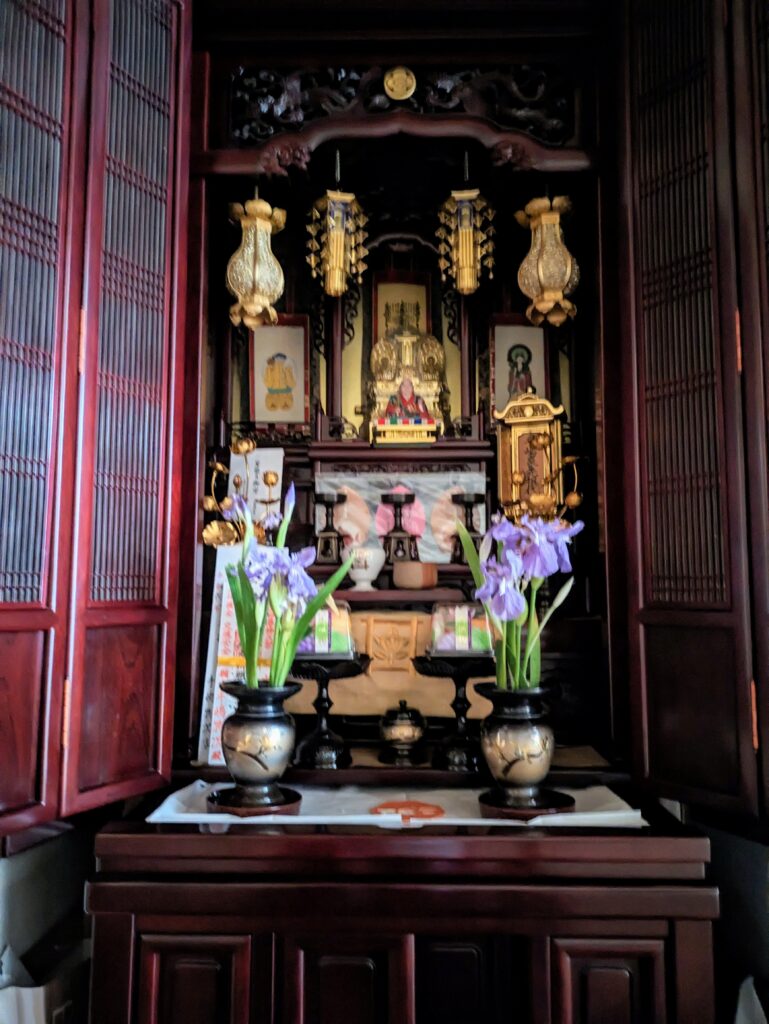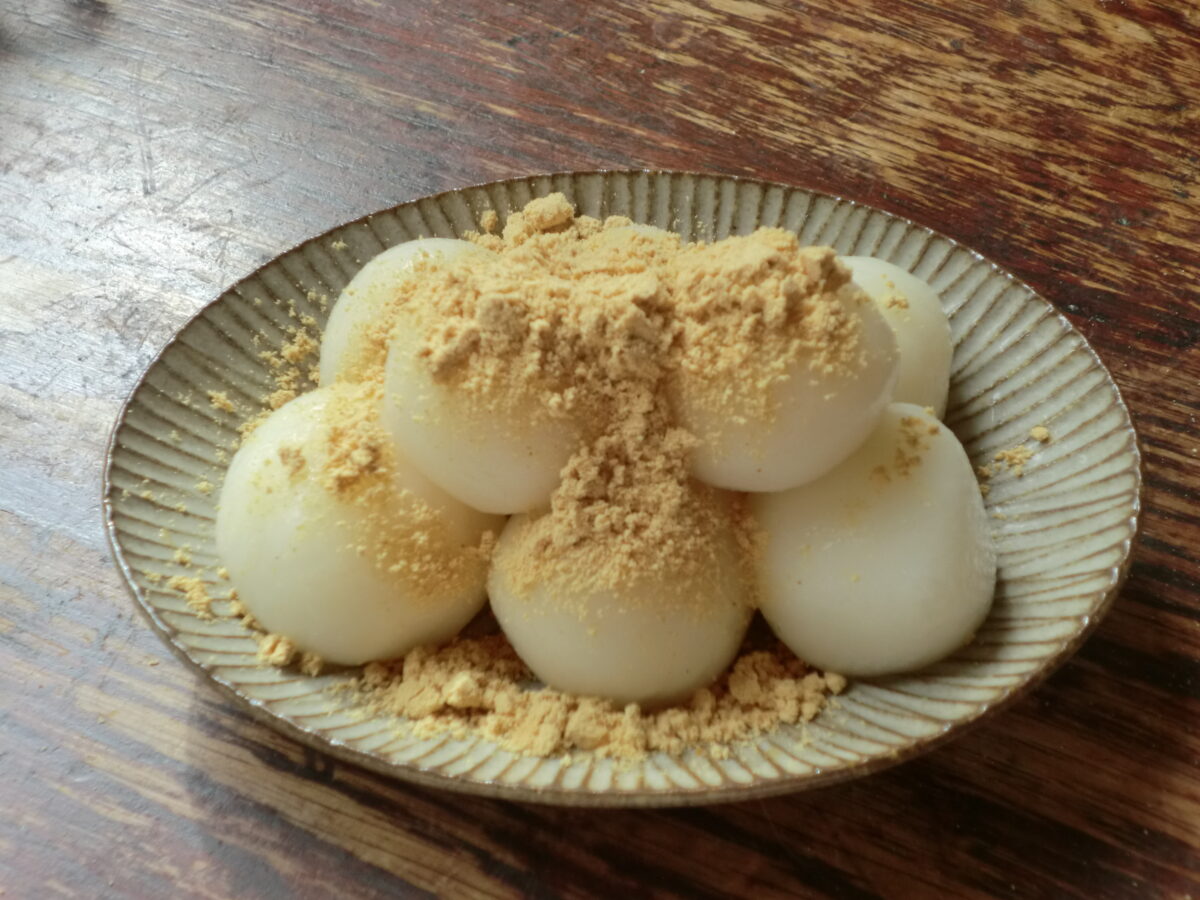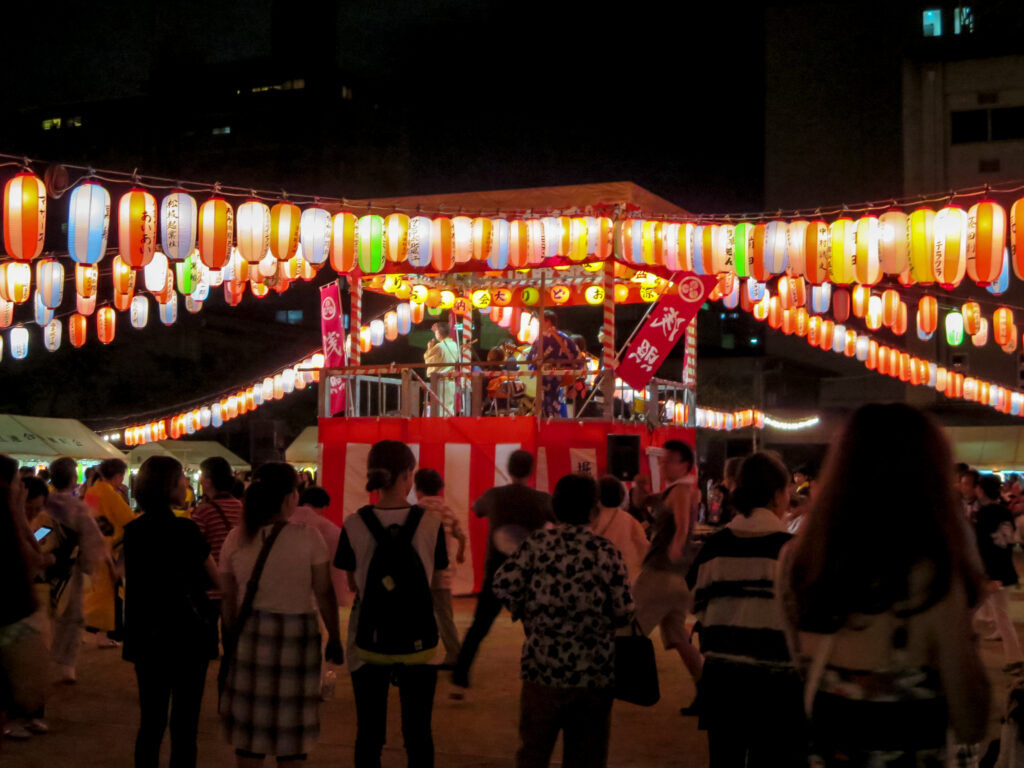Every summer, the Obon(お盆) season arrives, bringing with it visits to graves and homecomings, as people across Japan embark on extensive journeys. Obon (the Festival of Souls) is of particular significance for the Japanese people.
What is Obon?
Obon is an annual event in Japan that combines the ancient Japanese belief in ancestral spirits and Buddhism. Ancestral worship was deeply rooted in Japan long under the tenets of Shintoism before Buddhism was introduced, as documented in the book “Senzō no Hanashi” (Tales of Ancestors) by Kunio Yanagita. According to this belief, when people die, they do not go to another world but stay in the mountains near the home where they lived with their families. They are worshipped by their children, and over time, the spirits are purified, ascending to the higher parts of the mountain and becoming ancestral deities who watch over their descendants.
During the Obon period, it is customary for each household to welcome the spirits of deceased loved ones and ancestors back into their homes and to honour them. It is believed that the spirits of ancestors return from the “other world” (Anoyo), known as the “Pure Land” (Jōdo), to the world of the living (Konoyo). Families invite the spirits of their ancestors and departed loved ones back to the places they once lived, offering prayers for their happiness and peace in the afterlife.
Comparison of Shinto and Buddhist Obon
Shinto Obon is deeply rooted in Japan’s traditions of ancestor worship and nature worship. It is characterised by the reverence of ancestors’ spirits as deities and a strong emphasis on living in harmony with nature. In Shinto, rituals to welcome the spirits of ancestors are often performed at household altars (kamidana) or local shrines. It is common to offer natural objects and seasonal foods during these rituals. In some regions, Obon is celebrated as a festival that marks natural phenomena or seasonal changes, reflecting the Shinto belief in respecting the harmony of nature and the cycle of life.
Buddhist Obon, on the other hand, originates from the Indian Ullambana (Urabon) Festival, which is based on a story where Shakyamuni Buddha taught his disciple Mokuren (Maudgalyayana) the practice of making offerings to ancestors. Buddhist Obon typically involves visiting graves, offering food, and holding memorial services. The Bon Odori dance is also a well-known part of the celebration, symbolising the welcoming of spirits and expressing gratitude to ancestors. The festival reflects Buddhist teachings on the importance of filial piety and the transient nature of life.
The Buddhist event of Obon has actually evolved into its current form by incorporating Shinto beliefs. Originally, the Ullambana festival focused on honouring parents and ancestral spirits, but it did not include customs such as visiting graves or the idea that ancestral spirits return to the living world during this period. The modern form of Obon, where these practices are prevalent, appears to have been influenced by pre-Buddhist Japanese beliefs.
In Shinto, it is generally believed that the spirits of deceased ancestors become deities. Unlike Buddhism, which traditionally embraces the concept of reincarnation, Shinto holds that ancestral spirits watch over their descendants as gods. It was customary to welcome these spirits into homes and celebrate them during the Obon period. After the introduction of Buddhism and the incorporation of the Ullambana festival, these two traditions merged, leading to the current form of Obon, where people pay their respects to their ancestors.
What do people do during the Obon period?
The customs of Obon vary depending on the region, religion, or sect, but generally, during Obon, people offer flowers and incense at the family altar and spend time in the presence of their ancestors’ spirits. Across Japan, on August 13th, which marks the beginning of Obon, families set up a spirit altar (shōryōdana) in their homes, where they offer seasonal fruits, flowers, and visit the graves of their ancestors. The spirit horses (shōryō-uma) used in Obon decorations are symbolic vehicles for the spirits of ancestors to travel between the afterlife and this world. Cucumbers are fashioned into fast horses to represent a swift return, while eggplants are made into slow-moving cows to signify a leisurely journey back to the afterlife, carrying many gifts.
On the day Obon begins, or the day before, people light welcoming fires to guide their ancestors’ spirits home. Throughout the Obon period, families offer three meals a day to the spirits, invite monks to their homes to recite sutras, and conduct thorough memorial services. On the evening of the 15th, or in some regions on the 16th, families light a sending-off fire at the same spot where the welcoming fire was lit, to bid farewell to their ancestors’ spirits. Notable events during the sending-off include the famous cultural traditions such as Kyoto’s Gozan no Okuribi (Daimonji) and Nagasaki’s Shōrōnagashi (Spirit Boat Procession), which are iconic scenes of the Japanese summer.
Additionally, the Bon Odori, a traditional dance performed during summer festivals, is a dedication to the spirits during Obon. Bon Odori is performed in many regions across Japan, typically on the night of August 15th, which is believed to be the final night when the ancestors return to the afterlife. The dance serves as a grand farewell to the spirits on their last night.
When is the Obon period?
The timing of Obon varies by region. Traditionally, the Obon period spans four days around the 15th of the seventh month (from July 13th to July 16th) in the old calendar known as Kyūreki, which is a type of lunisolar calendar. During the Meiji era when Japan transitioned from the old calendar (Kyūreki) to the solar calendar, Obon festivities vary by region and can be divided into three main peiords:
- Shinbon (New Obon), July Bon: July 13-16 (only in certain areas centered around Tokyo)
- Kyuubon (Old Obon), August Bon, Month-delayed Bon: August 13-16 (throughout Japan)
- Kyuurekibon (Lunar Calendar Obon): Lunar calendar July 13-15 (in Okinawa and the Amami regions)
The most common period recognised as Obon is from August 13th to August 16th. As a result, many companies schedule their Obon holidays in August.
Why are different offerings made during Obon?
It is said that the deceased and ancestors spend their days in the Pure Land undergoing “training to be reborn into a better next life.” To show appreciation for their daily efforts and the fatigue from traveling back home, special meals are prepared during Obon to show our gratitude and wishes.
To allow the ancestors who have returned to rest comfortably at home, it is customary to offer grander than usual offerings, making Obon a special occasion. This hospitality serves as a form of memorial service. Offerings are often taken down and shared among those who have gathered for Obon after they have been presented to the ancestors. This practice symbolises the living receiving blessings from the ancestors, and it is considered a good thing.

What foods are taboo during Obon?
In Buddhism, there are dietary rules that practitioners should follow. If you are preparing meals with respect for Buddhist teachings, you should avoid including foods that are considered prohibited in the offerings or meals. Buddhist vegetarian cuisine is called shōjin ryōri (精進料理). Then the foods that should be avoided during Obon are called “sanen 三厭)” (three types of forbidden meat) and “gokun 五葷” (five pungent spices).
In Buddhism, animals such as mammals, birds, and fish are referred to as “sanen ” (three types of forbidden meat), and they are excluded from shōjin ryōri (Buddhist vegetarian cuisine). This idea is rooted in the teachings known as the “Five Precepts (五戒 Gokai),” one of which is the precept of non-killing (“fusei shokai 不殺生戒”), which prohibits taking the life of living beings and forbids the killing of animals. This teaching is observed during Obon, leading to the avoidance of the three types of forbidden meat. While protein can be obtained from meat, eggs, and fish, in shōjin ryōri, it is primarily supplemented with soybeans.
Also, ingredients with strong flavours or aromas, which are referred to as “gokun” (five pungent spices) or “goshin” (five pungent vegetables), are prohibited. This is because it is believed that consuming them stimulates worldly desires. These foods mainly include vegetables such as garlic, onions, leeks, chives, and pickled shallots.
In the past, most households strictly adhered to these rules, but nowadays, there is a trend that does not impose such strict restrictions on offerings or meals. The awareness of following Obon customs has diminished over time. In modern times, fewer families strictly observe the teachings of the “Five Precepts” in their meals, and many households now offer favourite foods or home-cooked dishes that the deceased or ancestors enjoyed in their lifetime, hoping that they will appreciate these offerings.
What are the staple foods for Obon?
The offerings placed in front of the family altar during Obon are important meals dedicated to the ancestors who have returned. One of the special dishes during Obon is shōjin ryōri, which refers to traditional cuisine made with ingredients that follow Buddhist teachings. It is offered on a tray called “ryōguzen(霊供膳)” during ceremonies. “Shōjin(精進)” in Buddhism means “to act with restraint to remove worldly desires and focus entirely on the path of Buddha,” and shōjin ryōri(精進料理) is known as the diet of ascetic monks.
In addition to shōjin ryōri, there are a variety of offerings, including nationally famous offerings and region-specific items, that are presented during Obon. For example, Sōmen, a staple food during the summer, is often offered during Obon. There are various reasons for this tradition, including the belief that the thin, long noodles symbolise a wish for long-lasting happiness. Another belief is that sōmen represents the reins or tether of a shōryō-uma (spirit horse), which ancestors are believed to ride. Additionally, it is believed that eating sōmen can prevent epidemics, and thus it has been eaten with hopes for the family’s health.

In regions such as Kyoto and Western Japan, dango (sweet rice dumplings) are made and offered during Obon. There are two types of dango: “mukae dango” (welcome dango) and “okuri dango” (send-off dango). Mukae dango, offered to welcome the ancestors, includes white dango such as shiratama dango. It may also include sweet dango made with red bean paste or mitarashi dango, meant to soothe the ancestors’ fatigue from their journey back home. The other type of dango is Okuri dango, offered as a gift when the ancestors return to the Pure Land, is typically white dango, prepared as a farewell offering.
The Japanese Culture of valuing ancestors: my Experience during Obon
I came from Fukuoka in Kyushu in Western Japan, where the Obon period is from 13th August to 15th August. My father’s family practices Nichiren Buddhism, and my mother’s family practices Jodo Shinshu (True Pure Land Buddhism), so I have experienced both sects of Obon, although I have experienced more of Nichiren Buddhism Obon because I lived with my father’s family.
I find Obon to be very special because I believe that the spirits of my ancestors come back and stay with us at my parents’ house during this time. On August 13th, we decorate the Buddhist family altar with flowers, sweets, candles, incense, and other items, while my mother prepares special dishes such as shōjin ryōri, Sōmen and dango (sweet rice dumplings) for our ancestors. In the evening, all the members of my family go to the family cemetery to bring the spirits of the ancestors back home. We pray in front of the Buddhist family altar and then serve the special dishes and kinako dango my mother cooked for them. We provide three meals each day for the three days.
On the evening of August 15th, we offer azuki dango to our ancestors before taking the spirits back to their graves. After seeing them off, I felt very nervous on the way back from the cemetery. This was because I had heard from my grandparents that if I were to trip on the way home, the spirits of the ancestors would not be able to return to the afterlife safely, which might be a superstition.
During the summer Obon season, we would reunite with relatives we hadn’t seen in a long time, visit graves, and enjoy pleasant family gatherings. Regardless of religious or sectarian differences, the feelings of remembrance and respect for the deceased and ancestors remain constant for Japanese people. While there are manners and regional customs to observe, it is still important to come together with family and relatives to enjoy peaceful times and have a meaningful Obon.
Obon is especially spiritual to me when I can sense the presence of my beloved dog, Polo wherever I am.
References:
https://hwpi.harvard.edu/pluralismarchive/news/japanese-festival-dead-obon-world-religion-news
https://www.worldreligionnews.com/religion-news/buddhism/the-japanese-festival-of-the-dead-obon/
https://www.lifedot.jp/ohaka-column-011
https://www.hasegawa.jp/blogs/kuyou/obon-meaning
https://www.bokksu.com/blogs/news/what-is-shinto
Images


